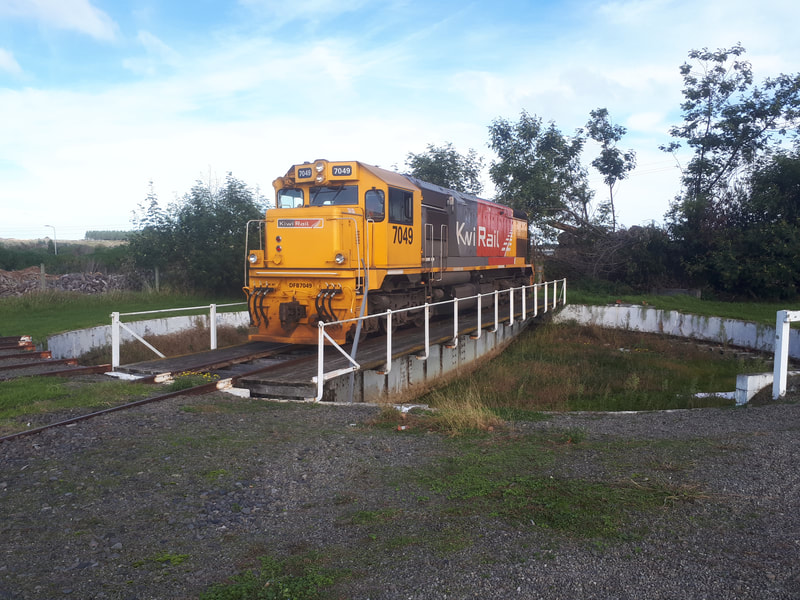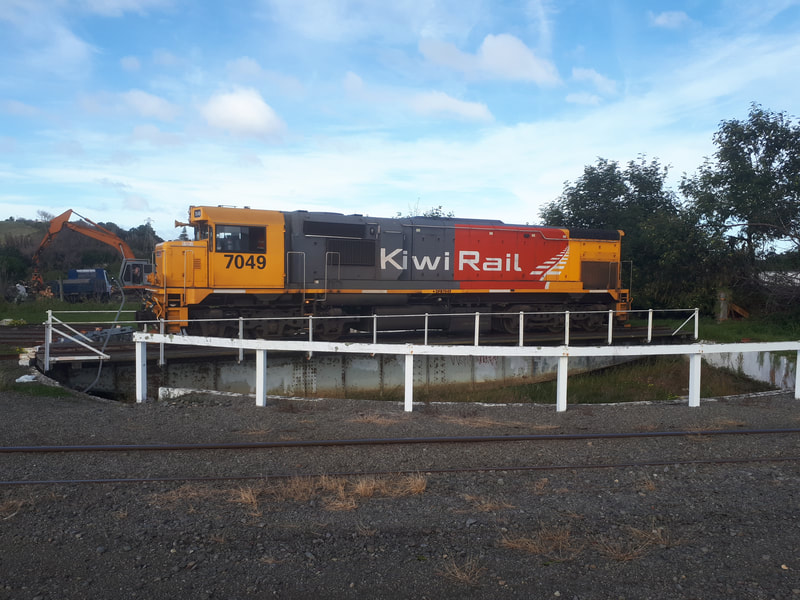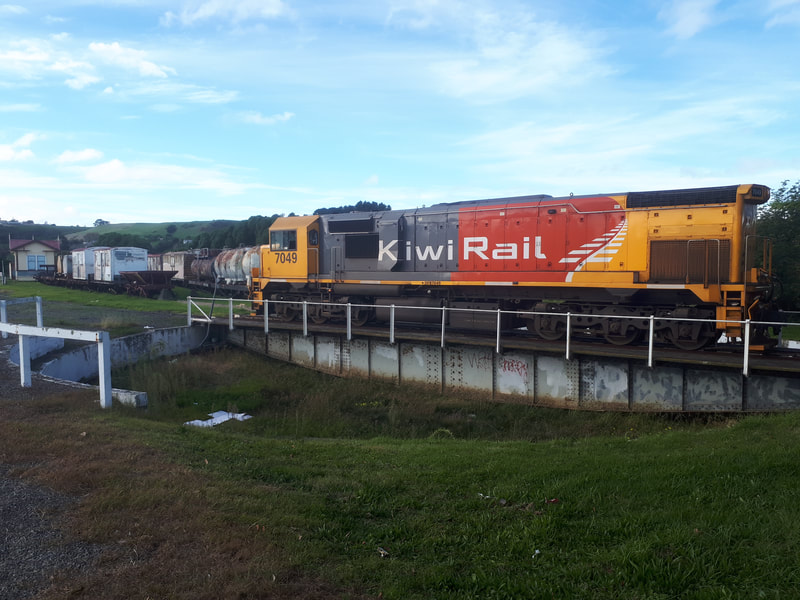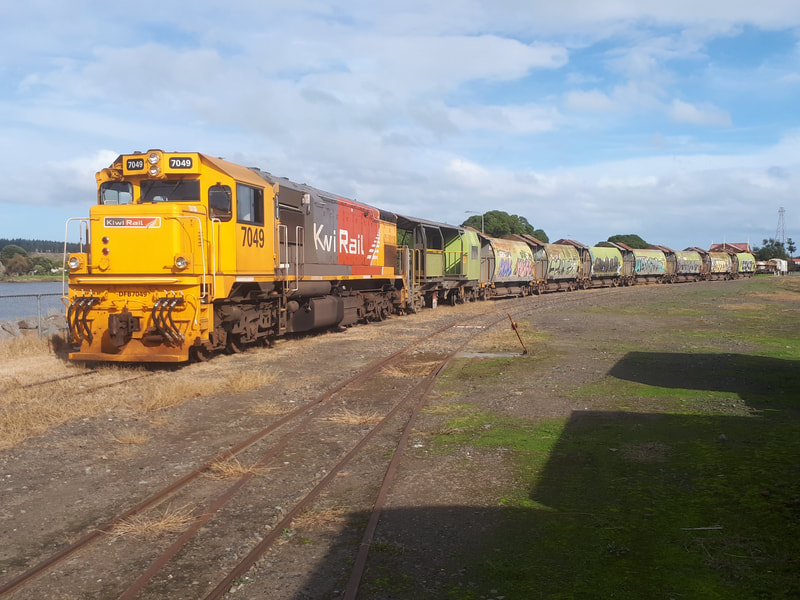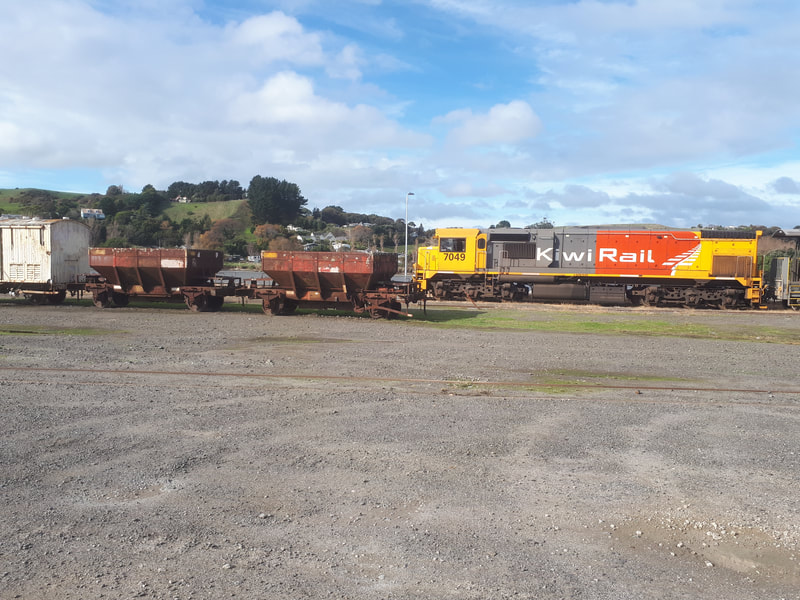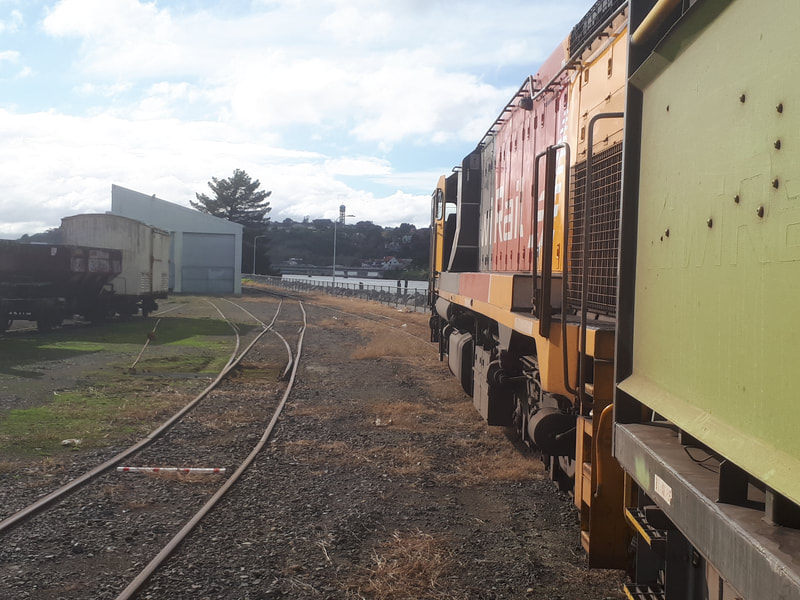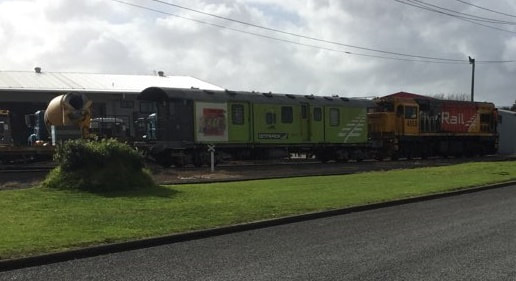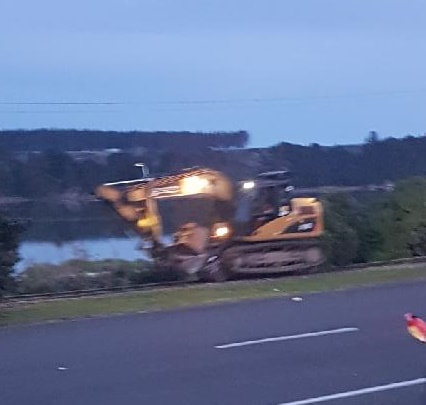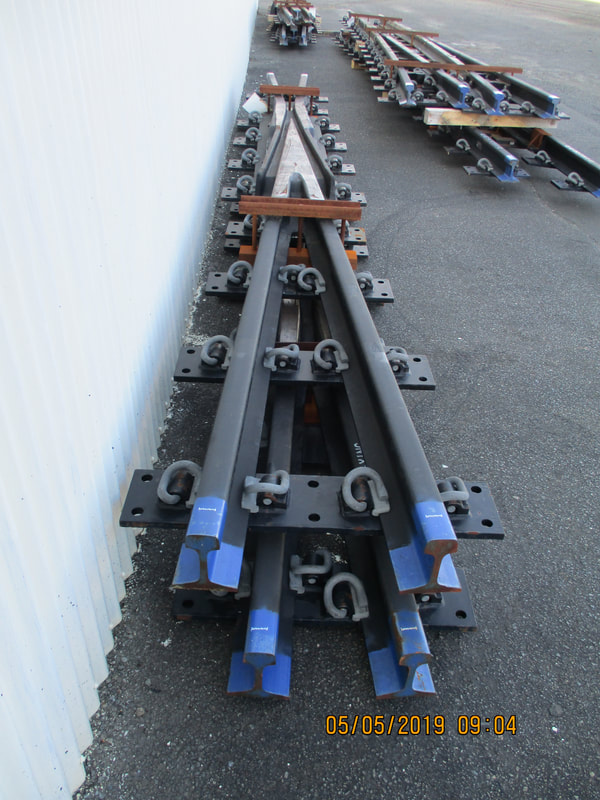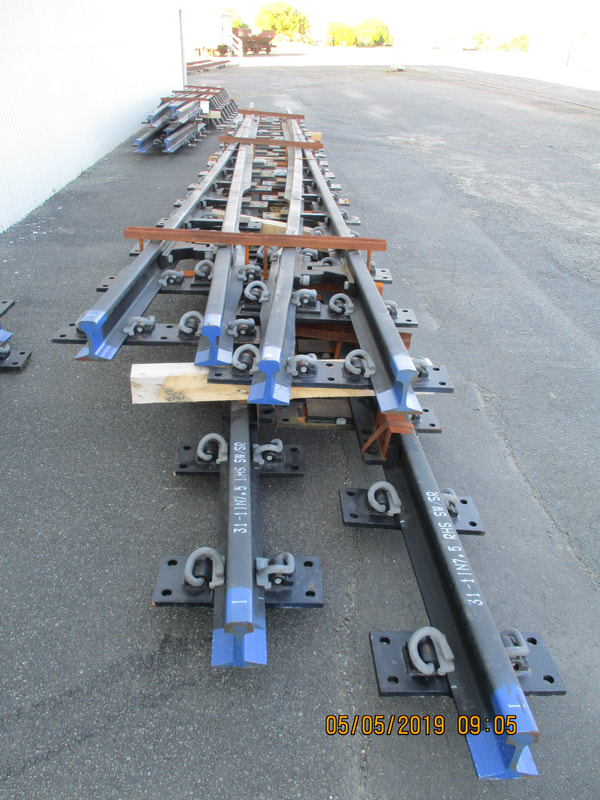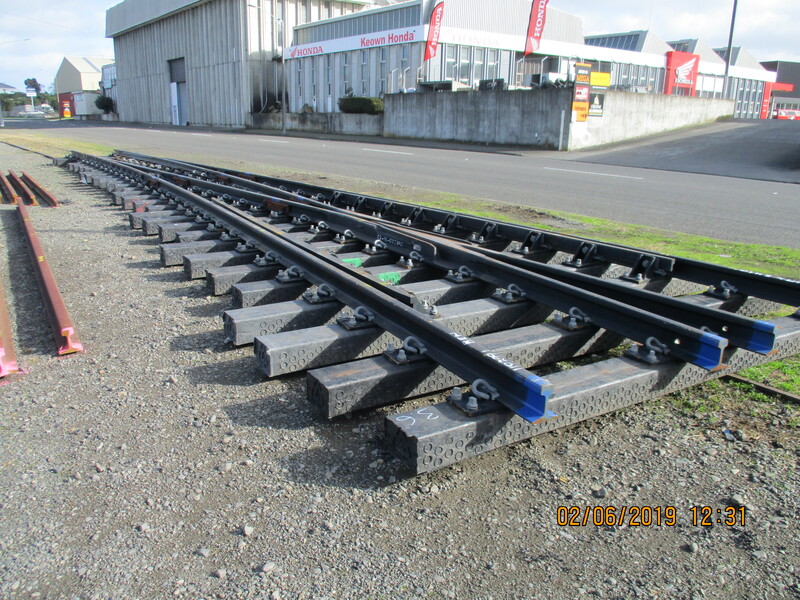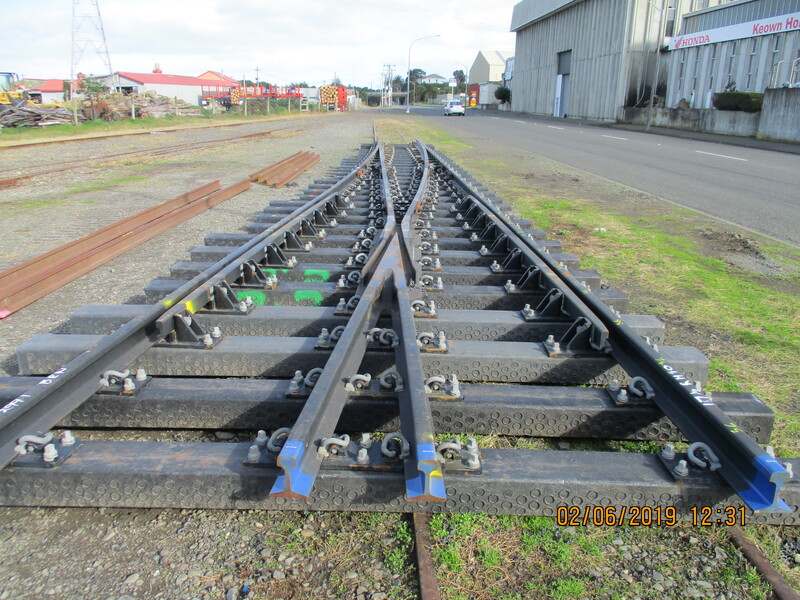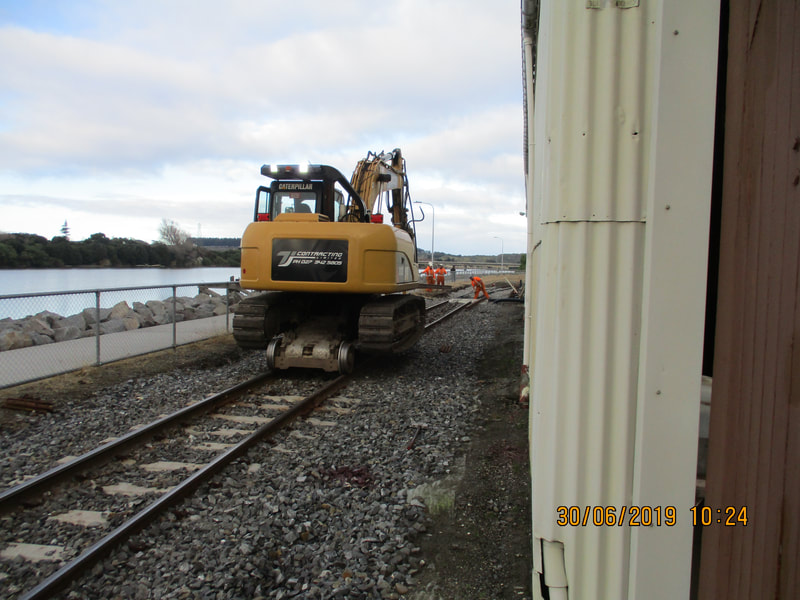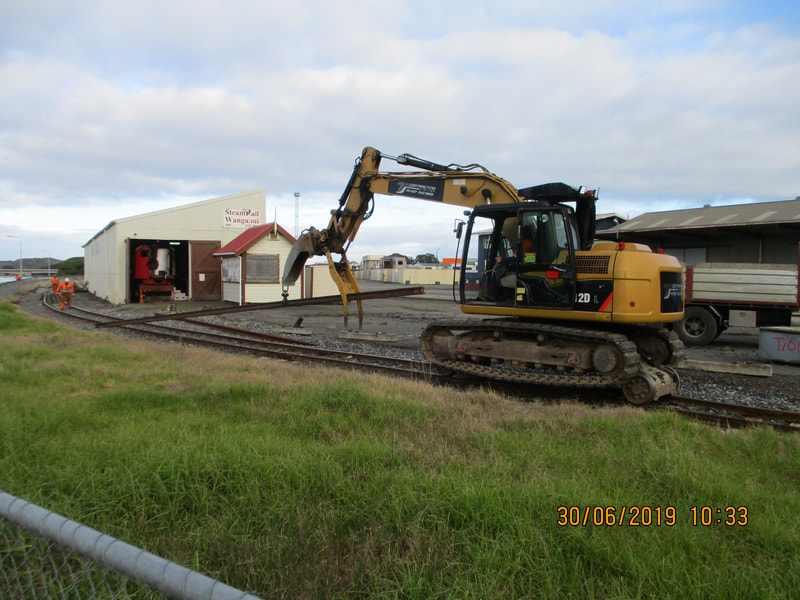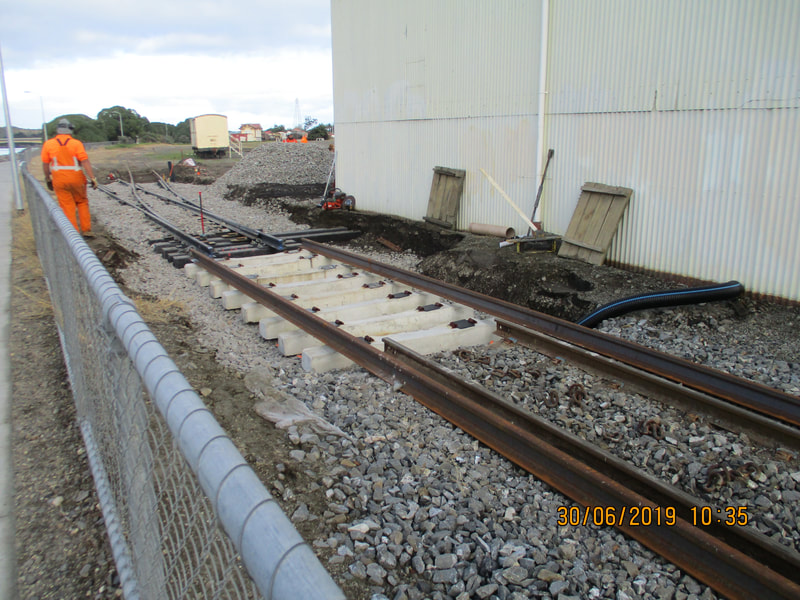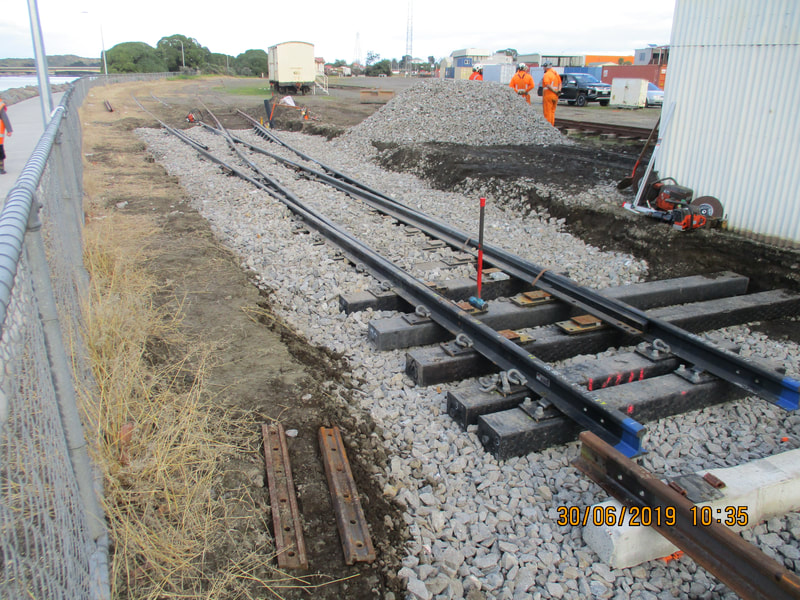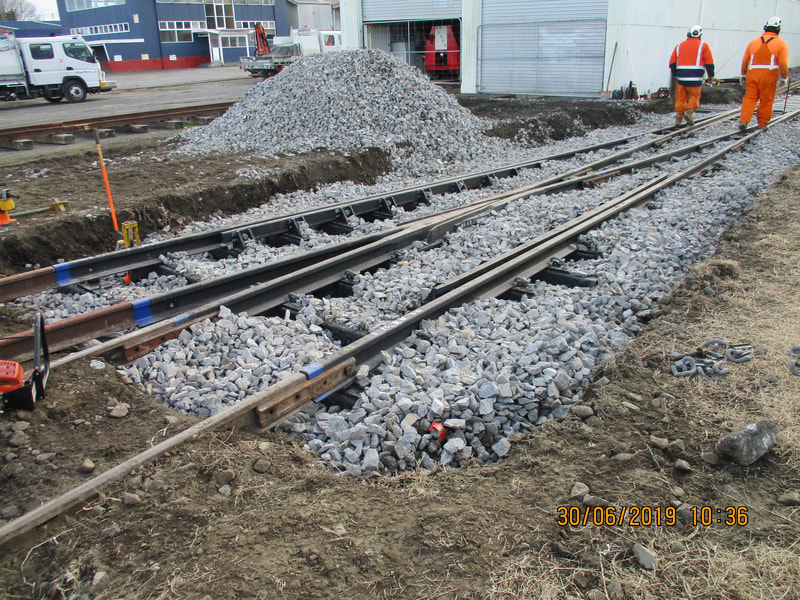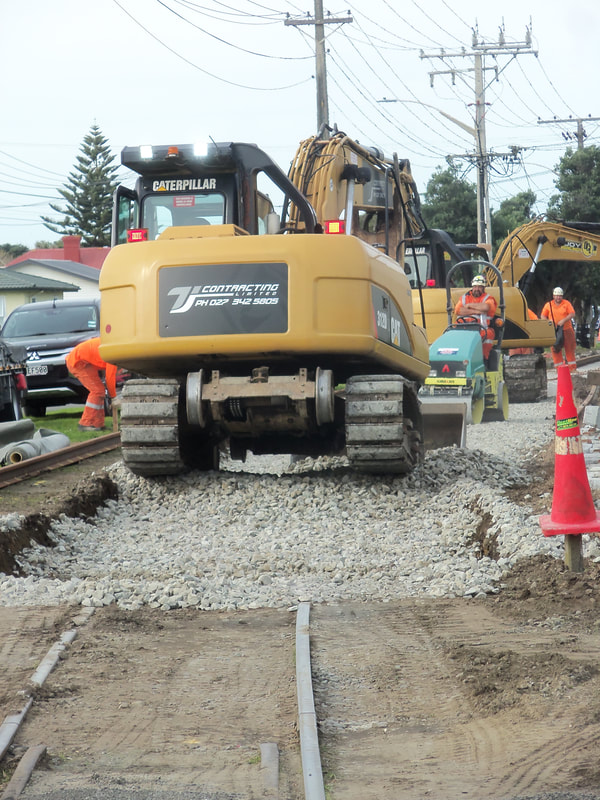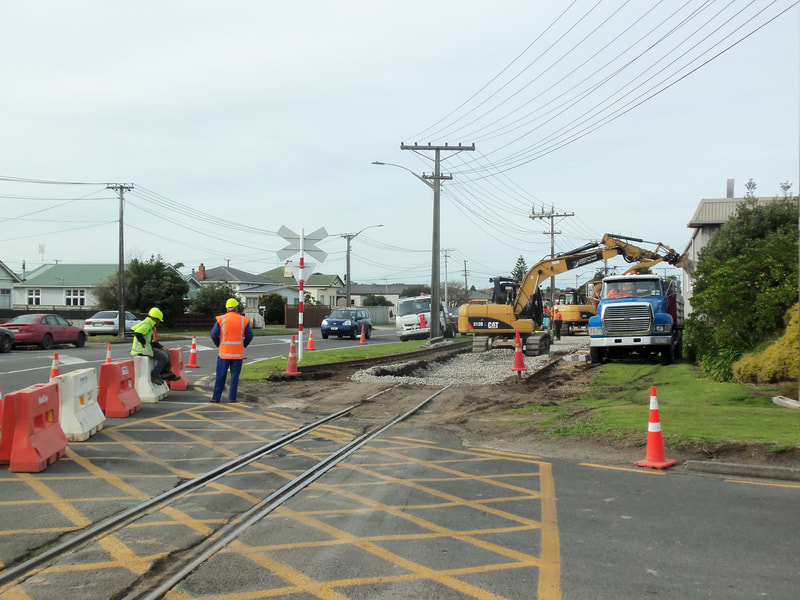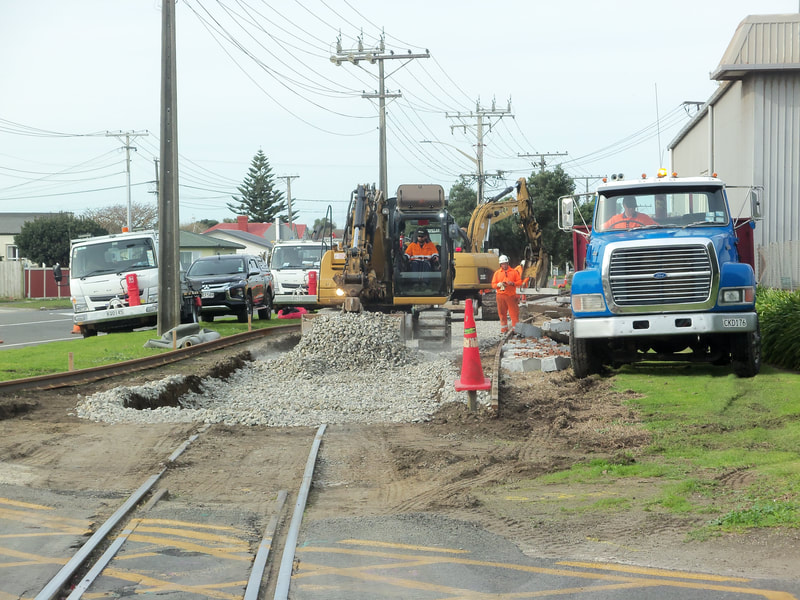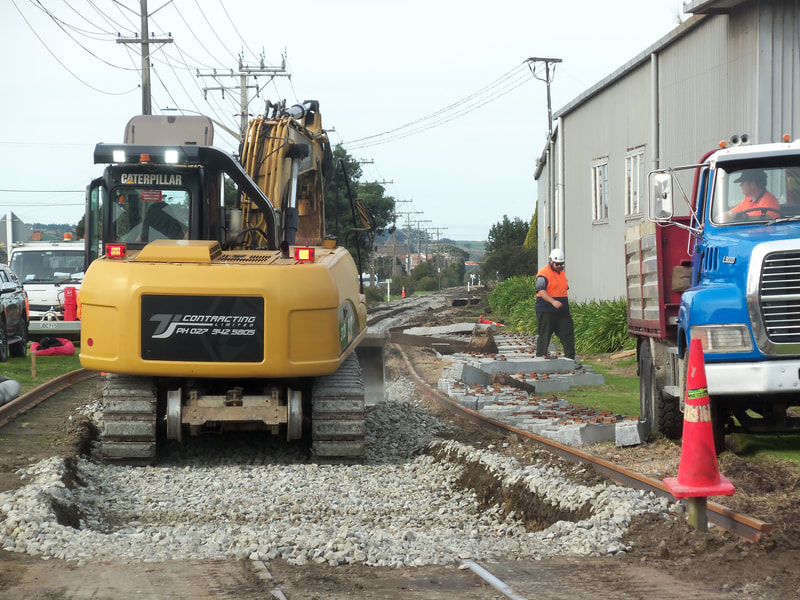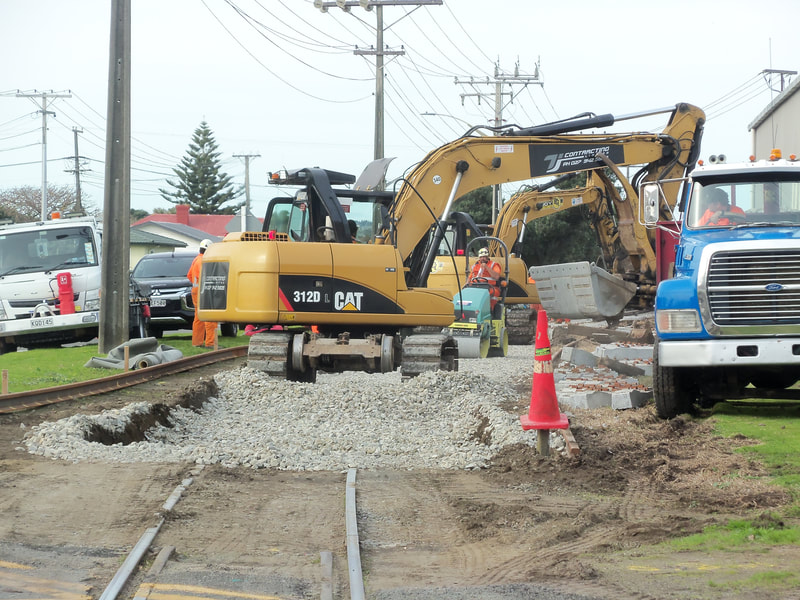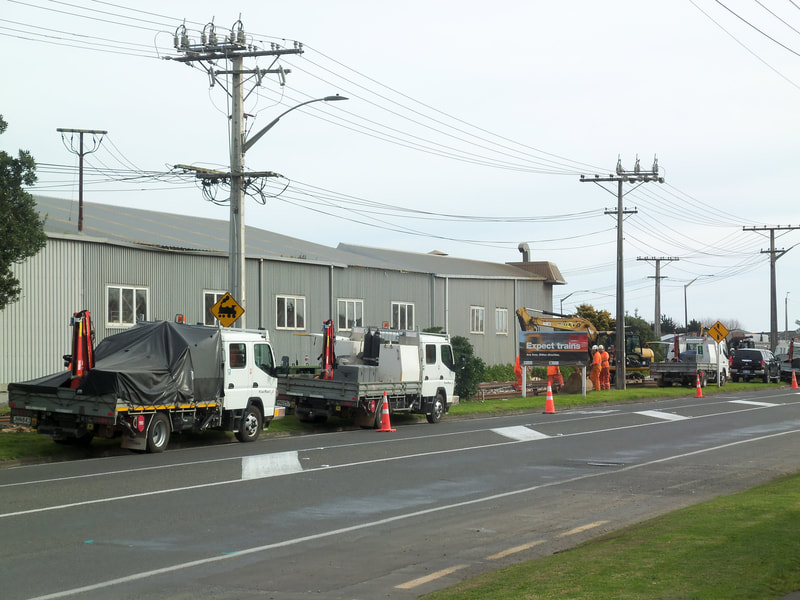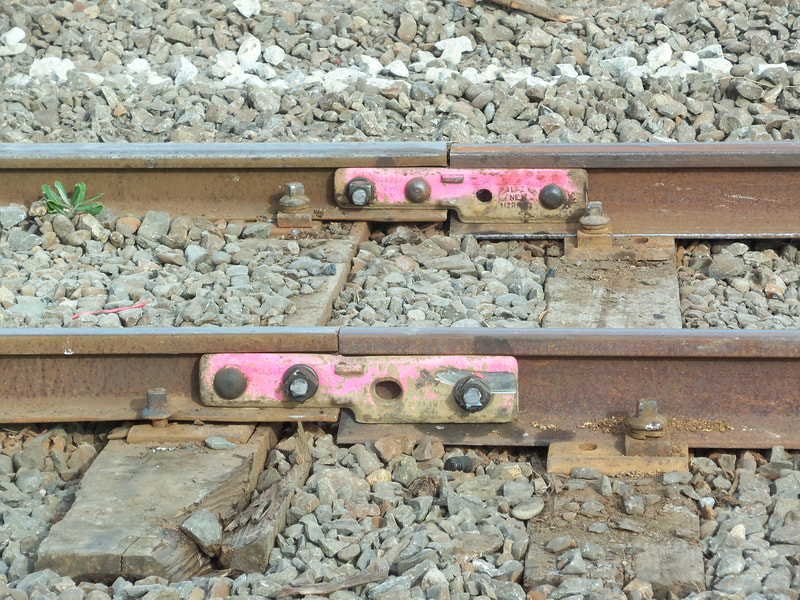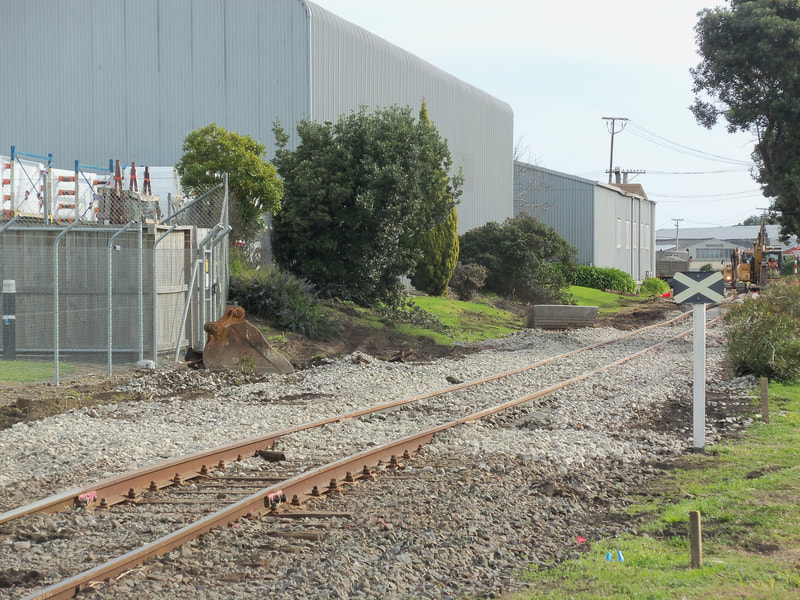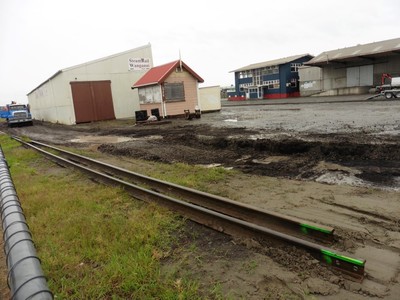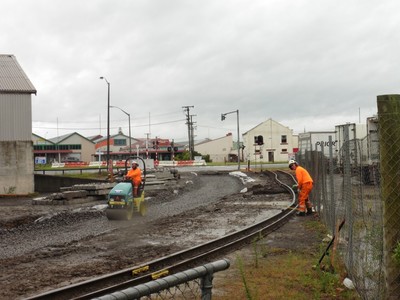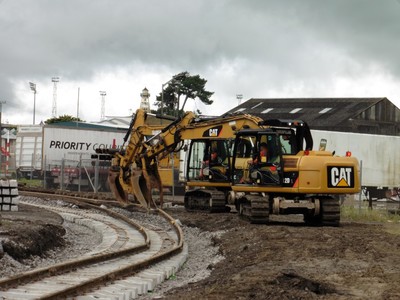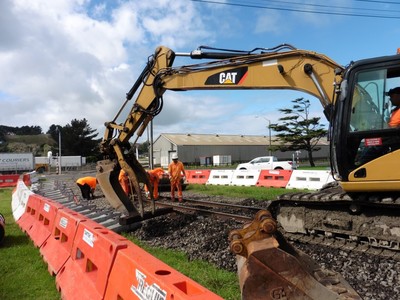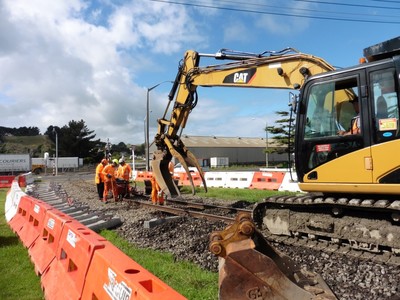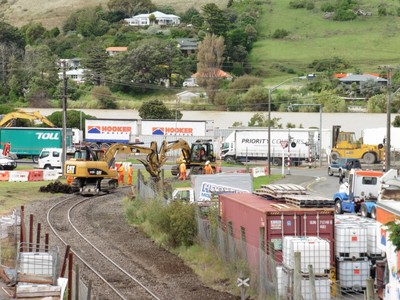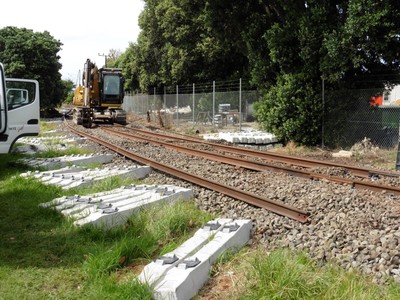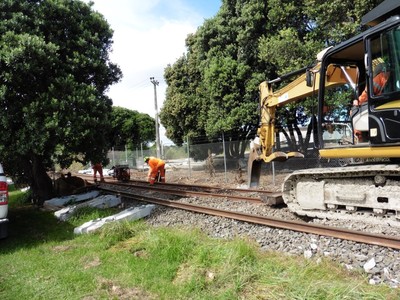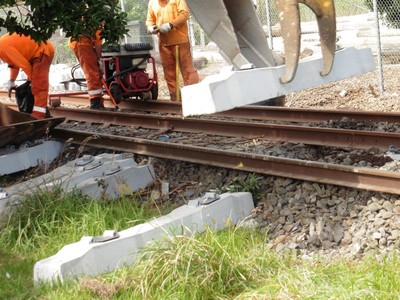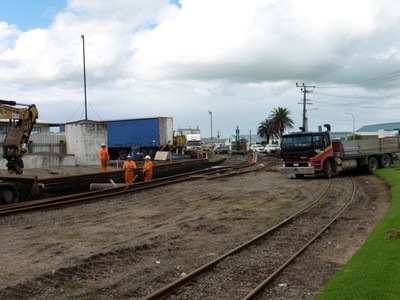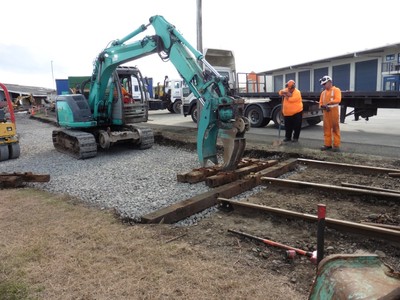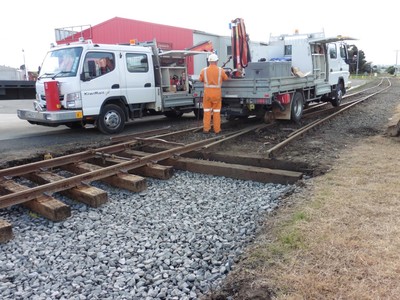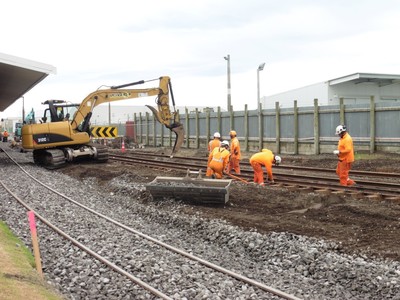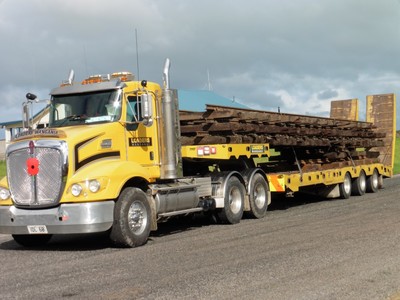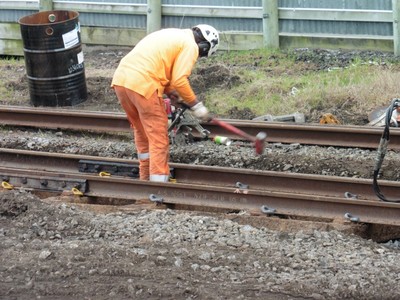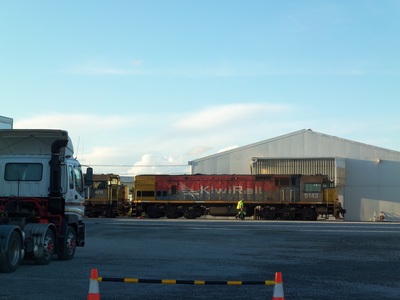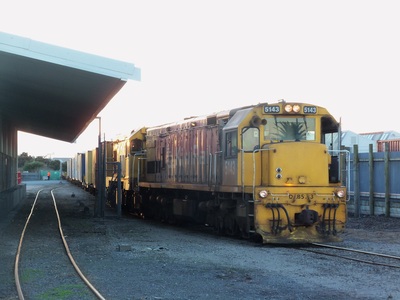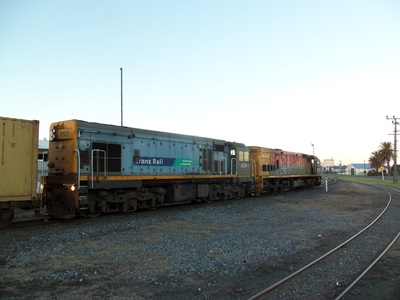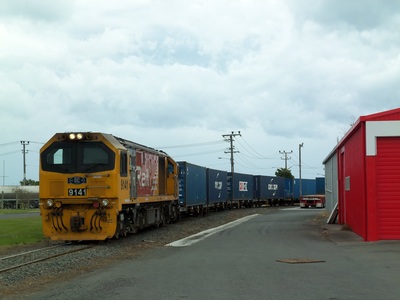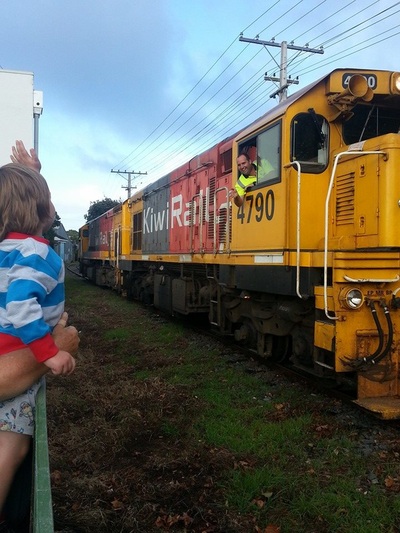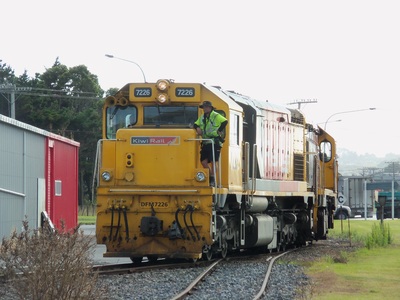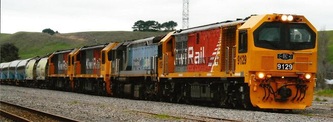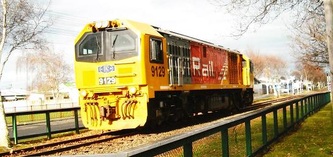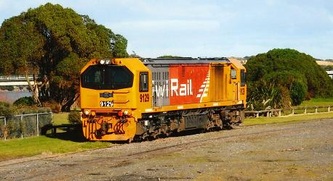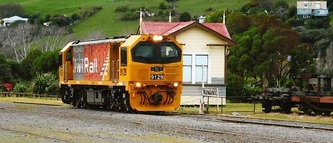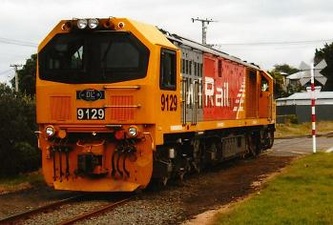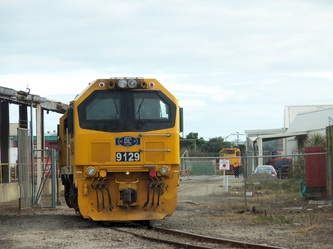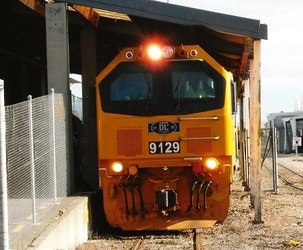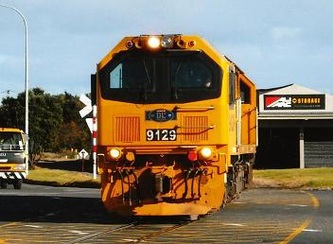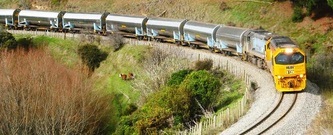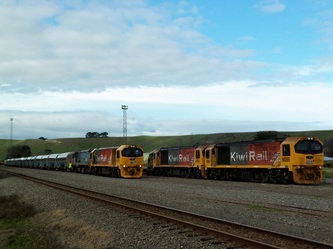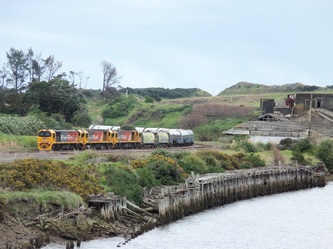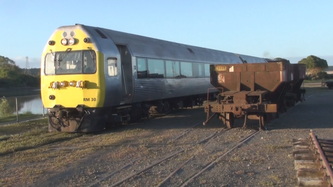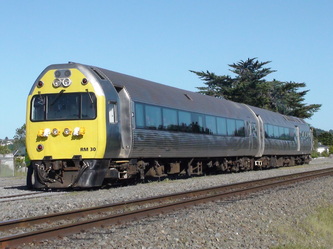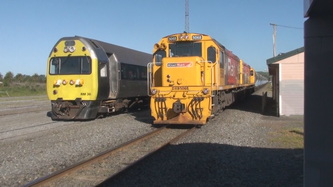KiwiRail In Wanganui
May - July 2019
Over the last couple of months KiwiRail has been very busy around the Wanganui area. Not only with the normal daily container or log trains into or passing through the city, but with a lot of Work Trains (Maintence Trains) also happening in the area. These have included ballast trains spreading ballast from Marton up to Whareroa (the first 6 photos were taken by Blair on the 30th of May when he worked on one such train, after spreading ballast from Marton to Turakina, he had to bring the train down the Wanganui Branch to turn the loco to head back to P nth ). Welded Rail and Concrete Sleeper trains dropping of new rail and sleepers along the line including down the Wanganui branch, at the Wanganui Freight Centre (Taupo Yard, near the SRW shed) and out on the Castlecliff branch, over two days (July the 16th and 17th). Em 80 (the evaluation car) has also done a run to New Plymouth on the 17th of July, returning to Wanganui on the 18th. Before heading out the Wanganui and Castlecliff branch’s Friday morning July 19th. The other 3 photos were taken by Sandra Jordan and Juleen Warahi
This has in turn kept the track gang very busy. New points were delivered to the freight centre to replace the main line points beside the SRW shed and the ones by the bullocks crossing and were put in over the weekend of July 29th and 30th (the next photos were taken by Colin Hughes).
The Track gang was again busy, this time out the Castlecliff Branch on the weekend of the 27th and 28th of July. They were replacing rail and sleepers between the Imlay works and Heads Road crossing (final photos taken by Mark Seconi).
February to April 2017
Over the last couple of months things have been very busy in the Wanganui area for KiwiRail, especially for the track gang. KiwiRail over the next 3 years has decided to upgrade both the Wanganui Freight and the Castlecliff Branches. There has been several work trains out on the branch and the gangers have been out on the line replacing sleepers and track. Charley Masters has been out with her camera.
Sleeper replacement between Taupo Quay crossing and the SteamRail Wanganui shed.
Sleeper replacement between Taupo Quay crossing and Ridgway Street over bridge.
Sleeper and track replacement on the Taupo Quay and Heads Road S Bend by Tenix.
Work train dropping track off out at Open Country.
Sleeper and track replacement on main and loop at Open Country.
KiwiRail Weather Woes
With
all the bad weather and flooding around the district on the 21st of
June 2015, KiwiRail network was hit bad with the line North of Wanganui being closed
for over two weeks. Hamish Coull has put together some photos of damage done to
the network.
KiwiRail Wanganui Notes
February - May 2015
It has been a busy few months
for the Wanganui area. You may have seen that we now regularly have 3 locos on
the Wanganui Shunt. This is because of increased tonnage coming out due to the
new log siding at East Town being open now. Some days we have close to 2000
tonnes leaving Wanganui by rail and it’s only going to get bigger once the new
part of the Open Country dairy factory starts producing (photo of Wanganui
Shunt with ‘guess who’ at the controls was taken by Kylie Jordan). Track
Recording Car EM80 did run out on the Castlecliff Branch on Thursday the 30th
of April. This derailed on the curve heading from Taupo Quay onto Heads Road
due to the track being over gauge in one area and couldn’t return until the
track gang had fixed the problem (photo by Mark Seconi). On Thursday 14th
of May there was a load test train run from P Nth to Whareoa. This featured 2
DL’s up front with 6 YJ Ballast Wagons, 3 YL Side dumpers, EP Plough Van, MUK
test wagon,18 OM Milk Tanks and then another 6 YJ’s on the rear (35 wagons
total) weighing just over 1400 tonnes (the limit for the Westmere Bank is
normally 1200 tonnes). This included stopping on the bank to see if the locos
could hold that weight and restarting again without the weight pulling them
backwards (photo taken by Mark Seconi). Also on that night with all the rain
and bad weather the area has had train No 523 hit a slip North of Wanganui.
Luckily the train didn’t derail and made it to East Town safely but the line
North of Wanganui was closed afterwards with a mention of a small slip on
Westmere Bank and another big one near Whareoa. (Photo of train at East Town
taken by Loco Engineer Shawn Monaghan).
Triple Header on Castlecliff Branch
Another possible first. A triple header on the Castlecliff Branch happened on Monday 8th of September with DC's 4571, 4041 and 4634, all in KiwiRail colours. Photos taken by Mark Seconi.
New Milk Season Starts
The first loaded milk trains started on Monday the 25 of August with the first train (542) hauled by DXB 5143 and DFB 7173 and 16 OM tank wagons, with the driver being your Club's President. The first day had two milk trains running, the second three and by Wednesday four milk trains were running. Looks like it will be a great start to the milk season with plenty of milk around.
DC 4058 Derails in the Wanganui Freight Centre
On Friday the 22nd of August, DC 4058 returning from Castlecliff on the Wanganui shunt (561) spit the points as it entered the Wanganui Freight centre yard (Taupo Quay) on the way back to East Town. The local train spotters were out in force and the loco was lifted back onto the rails by Emmetts Cranes. Once the loco was clear the wagons were taken away by another DC. A special Saturday shunt was run to pick up DC 4058 once all safety checks had been done and it was cleared to run back to P Nth. The derailment damaged the points so the mainline was out of action for a couple of weeks and all trains had to go to and from Castlecliff via the loop in the yard. Photos taken by Kylie Jordan.
Tamper works mainline through East Town
On Friday the 25th July, a‘Harsco’ tamper and ballast regulator were spotted making their way through East Town.
At the beginning of the work day, the track machines had started on the outskirts of Wanganui East and by 3.00pm had completed all of the mainline right up to the Aramoho Bridge.
The tamper would first roll along the line it was about to start on and record the rail as it rolled. Then it would back up and begin tamping the track using the information gathered from the first journey. Care and attention was taken at turnouts, crossings and where there was track circuit wiring.
The tamper was ETM 648 and the regulator was ETM 635. Some SRW members might remember these machines being on display in brand new condition at KiwiRail’s Palmerston North ‘Rail 150’ display in 2013. The machines continued further up the MNPL over the following period utilising the quiet time before the milk season starts. Written and photos taken by Mark Seconi.
At the beginning of the work day, the track machines had started on the outskirts of Wanganui East and by 3.00pm had completed all of the mainline right up to the Aramoho Bridge.
The tamper would first roll along the line it was about to start on and record the rail as it rolled. Then it would back up and begin tamping the track using the information gathered from the first journey. Care and attention was taken at turnouts, crossings and where there was track circuit wiring.
The tamper was ETM 648 and the regulator was ETM 635. Some SRW members might remember these machines being on display in brand new condition at KiwiRail’s Palmerston North ‘Rail 150’ display in 2013. The machines continued further up the MNPL over the following period utilising the quiet time before the milk season starts. Written and photos taken by Mark Seconi.
New turnout at Aramoho Jnc
The turnout that makes up the junction between the MNPL and our town branch has been replaced. The old turnout dated from 1986 and had become dangerously worn in recent years. The turnout was
a very long one, with the switch blades on the Aramoho bridge abutment on one side of Somme Parade, and the turnout’s frog on the other side of the Parade. The centre of it was of course buried in the crossing’s asphalt. The long length of the turnout gave the trains a great alignment leading onto the bridge from both the mainline and branch, but gave the track maintainers a headache when it
came time to access the track fittings. The crossing surface had been getting a thrashing from both rail and road traffic and had been the subject of critical Chronicle stories from time to time.
The new turnout is immediately to the west of the crossing and was installed over a weekend in June. The old turnout was removed two weeks later over the weekend of the 5thand 6th of July meaning that Somme Parade traffic was diverted through the Aramoho Railway Yard. Members reading this
newsletter who live in Aramoho would have found the temporary crossing very interesting to navigate.
With the old crossing turnout now replaced with a new simple track set and matching rubber mat road surface, users of the crossing will no longer notice the‘kadump kadump’ sounds their car’s used
to make running over multiple rails.
One unusual characteristic of the new alignment has emerged. KiwiRail has installed the new
left hand turnout part way into the main line’s right-hand curve so trains heading onto the branch curve for a short time towards Aramoho before ‘dog legging’ left and onto the branch. But one track worker working on the job said that it does not matter in the greater scheme of things, as trains onto the
branch have always been restricted to 25km/hr. Written and photos taken by Mark Seconi.
a very long one, with the switch blades on the Aramoho bridge abutment on one side of Somme Parade, and the turnout’s frog on the other side of the Parade. The centre of it was of course buried in the crossing’s asphalt. The long length of the turnout gave the trains a great alignment leading onto the bridge from both the mainline and branch, but gave the track maintainers a headache when it
came time to access the track fittings. The crossing surface had been getting a thrashing from both rail and road traffic and had been the subject of critical Chronicle stories from time to time.
The new turnout is immediately to the west of the crossing and was installed over a weekend in June. The old turnout was removed two weeks later over the weekend of the 5thand 6th of July meaning that Somme Parade traffic was diverted through the Aramoho Railway Yard. Members reading this
newsletter who live in Aramoho would have found the temporary crossing very interesting to navigate.
With the old crossing turnout now replaced with a new simple track set and matching rubber mat road surface, users of the crossing will no longer notice the‘kadump kadump’ sounds their car’s used
to make running over multiple rails.
One unusual characteristic of the new alignment has emerged. KiwiRail has installed the new
left hand turnout part way into the main line’s right-hand curve so trains heading onto the branch curve for a short time towards Aramoho before ‘dog legging’ left and onto the branch. But one track worker working on the job said that it does not matter in the greater scheme of things, as trains onto the
branch have always been restricted to 25km/hr. Written and photos taken by Mark Seconi.
First DXB Class loco on Castleclff Branch
What is believed to be the first DXB class loco to run on the Castleclff Branch happened on the 9th of May with Dxb 5143 being brought down the branch to assist DC 4219 with train 561. This also may well have been the first double header with locos facing the same way (elephant style) to run over the branch. Photos taken by Mark Seconi.
KiwiRail loco movements on the Castlecliff Branch
Over the last couple of months there has been a few different loco classes out on the Castlecliff branch. The
local train spotters were out in force getting photos. On the 3rd of January Dl 9141 became the second of its class to head out the branch and the first to pull a revenue service on the line after the Dc's broke down. Also Dfm 7226 headed
out the branch on 27 of January with your club's president at the controls. The Dfb/m/t class mates have also only been out the line a few times. Photos taken by Mark Seconi and Kylie Jordan.
Over the last couple of months there has been a few different loco classes out on the Castlecliff branch. The
local train spotters were out in force getting photos. On the 3rd of January Dl 9141 became the second of its class to head out the branch and the first to pull a revenue service on the line after the Dc's broke down. Also Dfm 7226 headed
out the branch on 27 of January with your club's president at the controls. The Dfb/m/t class mates have also only been out the line a few times. Photos taken by Mark Seconi and Kylie Jordan.
The DL Locos Come To Town
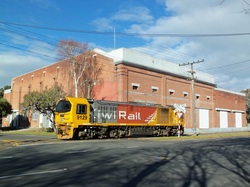
MS, Bedford Ave Crossing castle Cliff Branch
The arrival of the DL Locomotives for performance testing in the Wanganui District created much interest among the local rail enthusiast circles.
You have to scratch your head to remember when the last time it was, that a new locomotive came to town! Tranz Rail's rebuilt DQ's and QR slave locos were meant to be the promising new power on 1997's flash looking bulk milk trains. They didn't last long in the greater scheme of things. Three years earlier in Winter 1994, the DXR and the DFT's made their first appearances at East Town. These were early 90's rebuilds by NZ Rail who were seeking a cost effective way of re-equipping the fleet and keeping things up to date without actually having to buy new machines. In mid 1991 the Telecom train came to the Taupo Quay Yard with a DJ loco on the front. But the DJ wasn't a runner, only towed around as part of the display. Going back a little further, does anybody remember 'SteamRider 87' raising money for the Wanganui Volunteer Coast Guard? The EF class leader was brought to town by the Railways as part of a rolling stock display. This machine was described as "one of the giant new electrics"by the Wanganui Chronicle at the time. Needless to say the EF was not under power.
You probably have to go back to the early 1980's when the DSG's would have been first allocated to the city to find a brand new diesel-electric locomotive of note. But these locos are just shunting engines. Just before them would have
been the arrival of the 'maid of all work' DC class, which everybody knows are rebult DA's. Then we come to the DX locos of the 1970's. So prior to the arrival of the new DL class, you'd have to go back 30 plus years to witness a new mainline diesel-electric loco coming to town.
The first trip by a DL class member up the Marton-New Plymouth line was on 13 July 2011 when DL 9020 pushed a research test van and Dc 4634 to New Plymouth on a clearance and stability test run. The train returned to Palmerston North the next day with 9020 leading. The second visit by a DL was more recent on 4th June 2013 when DL 9129 went to New Plymouth as light engine. Along the way, it tested clearances through every crossing loop and major Taranaki siding where a DL could be expected to work in the future. 9129 returned back later the same day to Palmerston North in the pouring rain, wind and darkness. The third visit by a DL was on 7 June. DL's 9129 and 9193 brought 10 water laden OM's from Palmy to East Town. The wagons were dropped off at East Town and the locos ran to Marton Junction and return on driver training duties. The locos collected their wagons and were away again early afternoon. The Following week the whole process was repeated again.
MTT28 was a 'Mechanical Test Train' that arrived at East Town from Palmerston North on the morning of July 2nd with DL 9129, DFT 7213, DL 9089 and 9193. The once spacious East Town marshalling yard only has a few active roads in it now and the shunt crew had emptied the yard of log wagons to give the test train plenty of switching space. There were log wagons galore at the Aramoho yard as a result. After splitting the test train into two lots, DL 9129 headed off from East Town and ran into Wanganui Township and out to Castlecliff.
DL 9129 became the first of its class to visit the Town Branch and Castlecliff Industrial Line. It is interesting to note that no locomotive as large or as heavy as a DL has been along this branch before. The run was to check that the new locomotive would adequately fit through the turnouts and the siding at Molten Metals. Care was taken while checking clearances against old 'Hollanders' loading bank. And if all this was not enough for the local train spotter to take in, Wellington's DBR twins were out the back gate at Molten Metals as well! DL 9129 returned to East Town mid morning and hooked up with DFT 7213 and continued with the test train up the Westmere Bank and on to Waitotara. The train returned with 7213 leading. 7213 continued on with the shunt back to Palmerston North leaving East Town to be the overnight host for the three DL class members.
July 3rd was going to be intersting judging by what was planned. A triple header DL train to Taranaki. Rail enthusiast train chasers from Wellington and Auckland were in town for the event. A small crowd was gathering at the Blueskin Rd overbridge. The DL's were going to tackle the North Island's steepest railway. DL's 9129 and 9089 hauled 9193, two ballast wagons, 14 water laden milk wagons and two further ballast wagons trailing on the rear. The train looked and
sounded impressive while climbing the Westmere Bank. Apparently the train weighed 1468 tonnes. Further along the journey stops were made to test the locomotives brakes. The DLs had to prove they could hold a train on steeply
graded track. Also it was planned to trial powering a train away from a standing start with different traction motors isolated from the rest.
The whole train rolled through East Town the next day on its way back to Palmerston North.
Writen by Mark Seconi, photos taken by Mark and Colin Hughes.
You have to scratch your head to remember when the last time it was, that a new locomotive came to town! Tranz Rail's rebuilt DQ's and QR slave locos were meant to be the promising new power on 1997's flash looking bulk milk trains. They didn't last long in the greater scheme of things. Three years earlier in Winter 1994, the DXR and the DFT's made their first appearances at East Town. These were early 90's rebuilds by NZ Rail who were seeking a cost effective way of re-equipping the fleet and keeping things up to date without actually having to buy new machines. In mid 1991 the Telecom train came to the Taupo Quay Yard with a DJ loco on the front. But the DJ wasn't a runner, only towed around as part of the display. Going back a little further, does anybody remember 'SteamRider 87' raising money for the Wanganui Volunteer Coast Guard? The EF class leader was brought to town by the Railways as part of a rolling stock display. This machine was described as "one of the giant new electrics"by the Wanganui Chronicle at the time. Needless to say the EF was not under power.
You probably have to go back to the early 1980's when the DSG's would have been first allocated to the city to find a brand new diesel-electric locomotive of note. But these locos are just shunting engines. Just before them would have
been the arrival of the 'maid of all work' DC class, which everybody knows are rebult DA's. Then we come to the DX locos of the 1970's. So prior to the arrival of the new DL class, you'd have to go back 30 plus years to witness a new mainline diesel-electric loco coming to town.
The first trip by a DL class member up the Marton-New Plymouth line was on 13 July 2011 when DL 9020 pushed a research test van and Dc 4634 to New Plymouth on a clearance and stability test run. The train returned to Palmerston North the next day with 9020 leading. The second visit by a DL was more recent on 4th June 2013 when DL 9129 went to New Plymouth as light engine. Along the way, it tested clearances through every crossing loop and major Taranaki siding where a DL could be expected to work in the future. 9129 returned back later the same day to Palmerston North in the pouring rain, wind and darkness. The third visit by a DL was on 7 June. DL's 9129 and 9193 brought 10 water laden OM's from Palmy to East Town. The wagons were dropped off at East Town and the locos ran to Marton Junction and return on driver training duties. The locos collected their wagons and were away again early afternoon. The Following week the whole process was repeated again.
MTT28 was a 'Mechanical Test Train' that arrived at East Town from Palmerston North on the morning of July 2nd with DL 9129, DFT 7213, DL 9089 and 9193. The once spacious East Town marshalling yard only has a few active roads in it now and the shunt crew had emptied the yard of log wagons to give the test train plenty of switching space. There were log wagons galore at the Aramoho yard as a result. After splitting the test train into two lots, DL 9129 headed off from East Town and ran into Wanganui Township and out to Castlecliff.
DL 9129 became the first of its class to visit the Town Branch and Castlecliff Industrial Line. It is interesting to note that no locomotive as large or as heavy as a DL has been along this branch before. The run was to check that the new locomotive would adequately fit through the turnouts and the siding at Molten Metals. Care was taken while checking clearances against old 'Hollanders' loading bank. And if all this was not enough for the local train spotter to take in, Wellington's DBR twins were out the back gate at Molten Metals as well! DL 9129 returned to East Town mid morning and hooked up with DFT 7213 and continued with the test train up the Westmere Bank and on to Waitotara. The train returned with 7213 leading. 7213 continued on with the shunt back to Palmerston North leaving East Town to be the overnight host for the three DL class members.
July 3rd was going to be intersting judging by what was planned. A triple header DL train to Taranaki. Rail enthusiast train chasers from Wellington and Auckland were in town for the event. A small crowd was gathering at the Blueskin Rd overbridge. The DL's were going to tackle the North Island's steepest railway. DL's 9129 and 9089 hauled 9193, two ballast wagons, 14 water laden milk wagons and two further ballast wagons trailing on the rear. The train looked and
sounded impressive while climbing the Westmere Bank. Apparently the train weighed 1468 tonnes. Further along the journey stops were made to test the locomotives brakes. The DLs had to prove they could hold a train on steeply
graded track. Also it was planned to trial powering a train away from a standing start with different traction motors isolated from the rest.
The whole train rolled through East Town the next day on its way back to Palmerston North.
Writen by Mark Seconi, photos taken by Mark and Colin Hughes.
Silver Fern Railcar Visit 31 October 2010
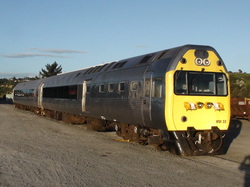
Silver Fern Railcar Rm 30 visited Wanganui on the 31 October 2010 and stayed the night. SteamRail Wanganui once again got hired to guard it for the night, this time in the Taupo Quay Yard.
